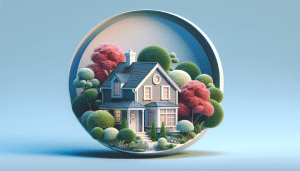What You Might Miss When Researching Smart Home Buying
Megan Gray October 16, 2025
Delve into the evolving world of smart home buying and uncover the factors shaping housing choices. This guide reveals how modern tech, financing trends, green home features, and community values influence what matters to buyers interested in real estate and housing.
Modern Home Buying Trends You Should Notice
Today’s home buying landscape is increasingly dynamic, marked by changing buyer priorities and significant technological advancements. The growing demand for real estate technology has shifted the search and transaction process online. Many prospective buyers first encounter homes through virtual tours and mobile apps, sparking interest before ever setting foot in a property. Easy access to online mortgage calculators, housing market data, and instant neighborhood information is transforming what it means to search for a new home. This evolution is apparent in how listings are displayed, using virtual walkthroughs and AI-powered recommendations to personalize the search experience and match buyers with homes faster than traditional methods could allow. For those researching smart home buying, noticing these technological touchpoints can make the difference in choosing homes that truly fit their lifestyle aspirations.
Another noticeable trend is the growing expectation of flexibility in both home features and financing options. Smart buyers are looking for properties that can adapt to their changing needs, whether it involves remote work spaces or the ability to age in place. Flexible floor plans and multipurpose rooms reflect this shift. At the same time, new financial tools are emerging, such as online comparison platforms for mortgage rates and digital-only lenders that expedite approvals. By streamlining paperwork and providing instant rate pricing, these services are leveling the playing field, especially for first-time buyers or buyers entering high-demand urban neighborhoods. Awareness of digital solutions helps buyers better evaluate affordability and market opportunities, rather than relying solely on traditional real estate agents for information.
Finally, transparency and data accessibility define the current market. Buyer concerns about home prices, local amenities, and school districts now have answers with a few clicks. Price history, recent renovations, and even walkability scores are openly shared on many platforms, helping buyers make better-informed decisions. Communities that adopt these technological advances often have higher buyer satisfaction and fewer surprises after move-in. Taking notice of these resources aligns with a smarter, more empowered approach to the home search — and can shape decisions from the first virtual viewing through closing day.
How Smart Technology Is Shaping Housing Decisions
The integration of smart technology within residential real estate is one of the most fascinating developments in housing today. Home automation systems, touchless entry, climate controls, and advanced security installations are no longer luxury features; they are becoming baseline expectations, especially among younger and tech-savvy buyers. For individuals searching for their next home, evaluating available smart features is now as important as reviewing square footage or neighborhood amenities. Properties with built-in smart home devices often command more attention on listing platforms and can offer competing advantages in a crowded market.
Furthermore, smart technology extends well beyond gadgets and connected appliances. Data-driven insights from smart meters reveal real-time energy consumption, providing residents with the opportunity to monitor – and reduce – utility bills. Such features are enticing in areas where energy costs are high or environmental consciousness drives buyer interest. Programs promoting energy-efficient appliances, as endorsed by organizations like ENERGY STAR, are increasingly cited in property listings. Buyers who prioritize sustainability in their smart home buying journey may find long-term savings and improved comfort in energy-conscious homes.
Smart home compatibility is also influencing renovation and remodeling choices. Homeowners are investing in infrastructure upgrades that support seamless Wi-Fi coverage and future device integration. Real estate professionals suggest that investing in modern cabling and robust wireless access points can enhance resale value and improve living quality. With the continued rise of smart devices, tech-enabled homes offer the flexibility and control buyers value − potentially swaying final purchasing decisions for those weighing similar locations or prices.
Financial Factors Influencing Buying Choices
Securing financing for a home is always a critical step, but the financial landscape itself is evolving fast. Interest rates, credit requirements, and down payment expectations fluctuate more closely with global economic conditions than ever before. Innovative mortgage products like adjustable-rate loans, interest-offset accounts, and digital payment tracking help buyers explore different scenarios for affordability. Tools that forecast monthly payments and overall loan costs allow greater transparency, giving buyers a clearer sense of long-term obligations before making offers. This level of insight supports informed decisions, especially as most buyers compare the true costs of ownership across multiple options.
Alternative financing sources have also gained popularity, from government-backed loans for first-time buyers to crowdfunding platforms assisting with down payments. While these options may not suit everyone, they reflect the diverse strategies available to achieve homeownership in today’s real estate market. Credit counseling, first-time buyer programs, and grant opportunities are widely promoted through public sector housing agencies and nonprofit organizations. Many buyers are surprised by eligibility for local initiatives supporting smart home installations or green retrofitting, making these features cost-effective in the long term. Exploring financial incentives is a wise step for those focused on sustainable and modern homes.
Lastly, affordability remains a top concern, especially in highly competitive regions. Rising home prices and stalled income growth make budgeting essential. Online affordability calculators and budgeting tools help buyers clarify what they can reasonably spend. Some real estate websites provide side-by-side pricing for properties in different districts, factoring in taxes, energy saving potential from smart features, or local amenities. This comparison helps highlight the practical impact of smart upgrades, both in daily living and in overall resale value. For those committed to financial sustainability, these tools are indispensable throughout the housing search.
Green Features and Sustainability in Modern Homes
Sustainability is a rising priority in real estate, often influencing both what buyers seek and how properties are priced. Green features such as solar panels, energy-efficient windows, smart thermostats, and water-saving appliances now appear in many listings. Buyers interested in sustainability often compare these features alongside more traditional considerations like commute times or school quality. Across the country, home certification standards (such as LEED or ENERGY STAR) signal that a property meets rigorous efficiency goals. This information matters, as green-certified homes often benefit from lower utility bills, improved indoor air quality, and increased resale appeal.
There is also evidence that energy-efficient homes promote healthier living environments. Proper ventilation, reduced volatile organic compounds, and smart climate controls contribute to a safer and more comfortable lifestyle. With climate change increasingly in the news, buyers are evaluating how sustainable their future homes might be. In some areas, government programs and local incentives help offset the costs of green upgrades, connecting buyers with rebates or reduced property taxes. Knowing about these perks can tip the scales when comparing otherwise similar properties.
The movement toward green real estate is not just about individual properties, either. Neighborhoods with shared community gardens, electric vehicle charging stations, and walkable layouts are gaining traction among smart and eco-focused communities. When weighing locations, buyers might consider the overall sustainability practices of an area as much as the specific green features of a house. This comprehensive approach can help buyers make investments that are environmentally responsible and future-resilient, aligning values with property selection in a rapidly changing world.
What Makes a Neighborhood Competitive for Buyers
Location is often cited as the most important factor in real estate, but the definition of a ‘good neighborhood’ has blurred. Today, buyers weigh community amenities, access to transit, safety technology, social engagement, and digital connectivity as much as they consider proximity to workplaces or schools. Areas with Wi-Fi hotspots, strong mobile signals, and integrated infrastructure for smart technology can have a clear edge, especially among younger buyers accustomed to a connected lifestyle. Listings with accessible tech amenities garner more views and inquiries, underscoring the impact of digital readiness in competitive neighborhoods.
School quality remains essential for families, but other factors — like green spaces, walkability, and safety features — are gaining prominence. Community security patrols, digital neighborhood watch programs, and smart street lighting reassure buyers about overall safety. Some regions even publicize real-time crime statistics, which helps buyers track trends objectively. A transparent approach to community well-being can foster trust and embolden hesitant buyers. As work-from-home and hybrid schedules become the norm, commute time may take a back seat to local amenities and quality of life features.
Civic engagement and neighborhood culture further differentiate locations. Buyers often gravitate toward areas with strong homeowner associations, vibrant local businesses, and opportunities for community participation. Digital groups and apps simplify involvement, allowing residents to share information, organize activities, and communicate about local events. These features not only foster a sense of belonging but also boost property values over time — making the smart community a key part of the modern home buying equation.
Tips for an Empowered Real Estate Search Experience
To get the most out of a smart home buying search, leveraging both technology and professional insight is essential. Begin by using online platforms to narrow options based on key features, desired amenities, and budget. Virtual open houses and smart filters help focus attention quickly on listings that align with buyer criteria. It is also wise to check for smart feature compatibility, energy certification labels, and available financing options in the listing descriptions. These elements can signal a better long-term fit and invite further exploration before arranging in-person visits.
Connecting with locally knowledgeable real estate agents adds another layer of expertise. Professionals who understand both the latest tech trends and traditional market dynamics can share insights that online research alone may miss. Ask agents about local incentives, upcoming neighborhood development, or the average time properties spend on the market. This intelligence can sharpen negotiation strategy and support smarter offers.
Finally, remain flexible and open to change. The market can shift quickly; new smart home products, regulations, or neighborhood amenities may emerge overnight. Set alerts for updated listings, pricing changes, or status updates in targeted neighborhoods. Keep notes and compare smart features carefully. An empowered search respects both research and intuition — creating a rewarding experience for buyers open to modern home possibilities.
References
1. U.S. Department of Housing and Urban Development. (n.d.). Buying a Home. Retrieved from https://www.hud.gov/topics/buying_a_home
2. National Association of Realtors. (2023). Home Buyers and Sellers Generational Trends Report. Retrieved from https://www.nar.realtor/research-and-statistics/research-reports/home-buyer-and-seller-generational-trends
3. ENERGY STAR. (n.d.). ENERGY STAR Certified Homes. Retrieved from https://www.energystar.gov/newhomes
4. U.S. Environmental Protection Agency. (n.d.). Indoor Air Quality (IAQ). Retrieved from https://www.epa.gov/indoor-air-quality-iaq/
5. LEED: U.S. Green Building Council. (n.d.). LEED Rating System. Retrieved from https://www.usgbc.org/leed
6. Federal Housing Finance Agency. (2022). Mortgage Markets and Trends. Retrieved from https://www.fhfa.gov/DataTools/Downloads/Pages/Monthly-Interest-Rate-Data.aspx








